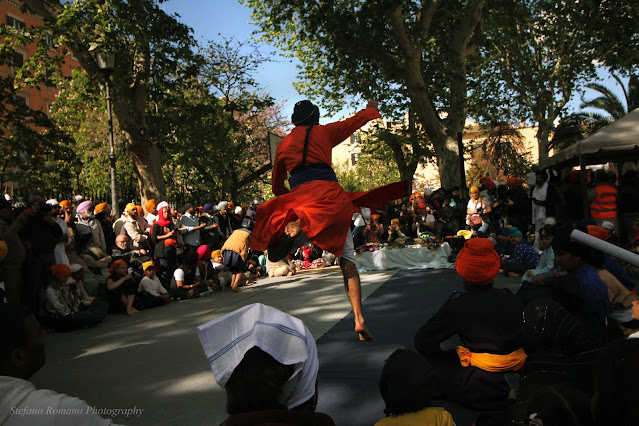 |
| Piazza Vittorio Park. Rome, 21 April 2024 |
Piazza Vittorio is once again colored by the bright clothes and turbans of the Sikhs during the Nagar Kirtan. For me, it is the fifth year and it is always a joy for the eyes, even if this year authorization was not granted for the parade along Via Merulana: a beautiful sight to see hundreds of people armed with swords and flowers parading in front the Basilica of Santa Maria Maggiore.
The festival took place right behind the Basilica in 2012 and in 2019 in Centocelle, but Piazza Vittorio remains the most symbolic and evocative place.
After offering the traditional food (langar), there was a long part of songs and prayers in front of the Holy Book and then the performance of the Sikh martial arts, gatka, in the presence of the Ambassador of India who was welcomed by a bouquet at the entrance to the Park.
This year the Nagar Kirtan was organized by the Massimina Gurudwara.
The Sikhs are an imposing and proud people who also know how to be kind and welcoming and there is nothing warmer than a severe face that melts into a sweet smile.
These are some of the selected photographs from the long Sunday.
A special thanks always goes to the very kind Navan.


April 13 or 14 is the beginning of the new solar year for the Sikh community (which means “disciple” from Sanskrit), a day that commemorates the baptism of the “Panj Piare” (the five devotees) at the hands of the tenth and last guru Gobind Singh, in 1699, hence the use of the surname “Singh” (lions) for men and “Khaur” (Princesses) for women.
Sikhism is a monotheistic religion born in the city of Anandpur Sahib, in 15th century India, based on the teachings of ten gurus who lived in India between the 15th and 18th centuries.
One of the youngest of the major religions, it is the fifth-largest organized religion in the world, comprising approximately 25 million Sikhs at the beginning of the 21st century. Sikhism developed from the spiritual teachings of Guru Nanak, the first guru (1469–1539), and the nine Sikh Gurus who succeeded him. The tenth guru, Gobind Singh (1676-1708), appointed the scripture Guru Granth Sahib as his successor, completing the line of human Gurus and establishing the scriptures as eternal and religious spiritual guidance. Sikhs are devotees of the Sri Guru Granth Sahib ji, the sacred scriptures of the ten gurus who succeeded one another from 1469 to 1708, and other lovers of the Creator. They live mainly in Punjab (northwest India). They pray to the omnipresent and omnipotent Creator, who manifests himself through creation and who can be reached thanks to prayer and the help of a guide, the guru, that is, the one who gives light (wisdom) to darkness (ignorance).



















Nice photos and info. Thanks for bringing their stories.
ReplyDelete